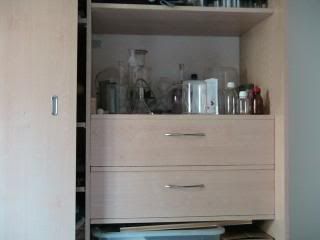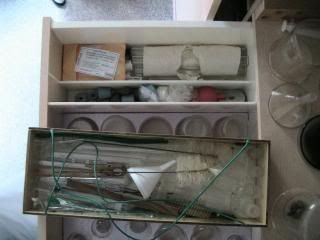
... The municipality wanted to have a conversation with me.
Unlike my expectation they were very excited about it and wanted to encourage such projects on condition that it was conform some basic safety rules such as having a fire extinguisher, having running water, always wearing a lab coat etcetera. They also want to see the lab when it is done (presumably to check whether it stays under control or not).
With a positive attitude I started with building (my lab was nothing more than an empty room).


 Closet
Closet Two tightly closing drawers, to keep things as dust free as possible
Two tightly closing drawers, to keep things as dust free as possible Drawers can be 100% pulled out (max content load = 15kg)
Drawers can be 100% pulled out (max content load = 15kg) Top drawer with foam holder for flasks & beakers
Top drawer with foam holder for flasks & beakers Small tray for adapters, test tubes &c can be taken out, giving access to my rubber stoppers and less frequently used objects
Small tray for adapters, test tubes &c can be taken out, giving access to my rubber stoppers and less frequently used objects Bottom drawer: tray for petri dishes, coolers, tubes, and the like
Bottom drawer: tray for petri dishes, coolers, tubes, and the like Bottom drawer: lower part for burette, quartz tube, syringes small flasks, other less frequently used glassware
Bottom drawer: lower part for burette, quartz tube, syringes small flasks, other less frequently used glassware